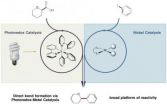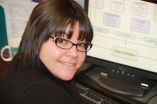(Press-News.org) Epidemiologists know that an important piece of evidence is often staring you in the face – but it's not always easy to see the forest for the trees.
Danish scientists recently teamed up with University of New Mexico researchers to test a powerful new method for predicting the progress of common diseases through time by teasing out previously undetected patterns from a very large data set – in this case, the health records of Denmark's entire population.
This approach maps out surprising correlations: a disease like gout – a form of arthritis – is strongly linked to cardiovascular disease, for example. In the future, this could enable physicians to make diagnoses sooner using simple tests in combination with known disease progression patterns.
The research is outlined in a study, "Temporal disease trajectories condensed from population-wide registry data covering 6.2 million patients," published Tuesday in Nature Communications.
Pope Moseley, MD, chair of UNM's Department of Internal Medicine and Tudor Oprea, MD, PhD, professor of Internal Medicine and chief of UNM's Translational Informatics Division, collaborated with researchers from the Department of Systems Biology at the Technical University of Denmark, the Novo Nordisk Center for Protein Research at the University of Copenhagen and the Institute of Biological Psychiatry at Copenhagen University Hospital.
"This is a leap into a fairly large data base," Moseley says. "This method is able to recognize patterns in data that not only include diagnostic patterns, but includes the element of time and is able to build networks from that."
Denmark's electronic health registry covers that nation's entire population, with each person assigned a health number, Moseley says. Each medical diagnosis is coded in the registry using the International Classification of Diseases terminology – 101 million unique diagnoses in all.
"Every diagnosis on every Dane from every hospitalization and outpatient clinic visit is entered into the national health registry for the last 14 years," he says. "You're able to take these mass of data and look at it over time and begin to draw associations."
The team boiled down the massive trove of data to 1,171 so-called thoroughfares with central information on the course of diabetes, chronic obstructive pulmonary disease (COPD), cancer, arthritis and cardiovascular disease.
Lead author Anders Boeck Jensen says this data analysis method made it possible to view diseases in a larger context.
"Instead of looking at each disease in isolation, you can talk about a complex system with many different interacting factors," says Jensen, a post-doctoral fellow at the Center for Protein Research. "By looking at the order in which different diseases appear, you can start to draw patterns and see complex correlations outlining the direction for each individual person."
Oprea points out an additional advantage of the data-mining method. "The disease trajectories in this study follow causal relationships that were identified by a medically agnostic software," he says. "This illustrates the power of data mining as a means to uncover novel disease relationships and its ability to inform the health care sector about new avenues in patient management."
The data analysis showed, for example, that a diagnosis of anemia is typically followed months later by the discovery of colon cancer, Oprea says, "which suggests that cancer lesions were present and occult bleeding occurred, but remained undiagnosed."
Meanwhile, in addition to identifying gout as a step on the path toward cardiovascular disease, the team made surprising findings about COPD.
"In just looking at these codes that were based on age and gender and where the code was done, we were able to say that COPD is diagnosed late," Moseley says. "It's therefore under-diagnosed and probably because of that undertreated. All we have is this diagnostic code, but our analysis of the pattern said that."
That finding received unexpected support last February when another team published a paper on a large epidemiological study of 6,000 Danish COPD patients, each of whom was interviewed and subjected to extensive examination, laboratory review and testing.
"Their conclusion is COPD is diagnosed late, under-diagnosed and undertreated," Moseley says. "We were able to come to the same conclusions without ever having gone the other way. We essentially did the experiment with a computer out of a health registry."
The research could yield tangible health benefits as we move beyond one-size-fits-all medicine, says Prof. Lars Juhl Jensen of the Center for Protein Research.
"The perspective is that your genetic profile or the total network of associated proteins in your body, your proteome, can be mapped in a few years' time, enabling you to suddenly learn things about yourself which can be used to forecast the progress of diseases over an entire lifetime," he says.
Søren Brunak, a professor at the Technical University of Denmark and Center for Protein Research who served as senior author on the paper, adds that the sooner a health risk pattern is identified, "the better we can prevent and treat critical diseases."
Moseley describes the partnership with the Danes as "a really very nice marriage . . . it's a strong informatics and systems biology collaboration." Going forward, he hopes to access the data for even larger populations.
“The author Williams Gibson said something like, ‘Everything we need to know about the future is here, now – you just have to be able to recognize the pattern,’” Moseley says. “Never was it more true.”
INFORMATION:
Mining mountains of data for medical insights
2014-06-24
ELSE PRESS RELEASES FROM THIS DATE:
Research explains action of drug that may slow aging, related disease
2014-06-24
Dietary restriction is one of the most-researched methods for slowing the aging process. Now, a new article published in The Journals of Gerontology, Series A: Biological Sciences and Medical Sciences helps explain the action of a drug that appears to mimic that method — rapamycin.
Rapamycin, an antibiotic and immunosuppressant approved for use about 15 years ago, has drawn extensive interest for its apparent ability — at least in laboratory animal tests — to emulate the ability of dietary restriction in helping animals to live both longer and healthier.
However, this ...
Hormones affect voting behavior, Nebraska researchers find
2014-06-24
OMAHA, Neb. – Researchers from the University of Nebraska at Omaha (UNO), the University of Nebraska-Lincoln (UNL) and Rice University have released a study that shows hormone levels can affect voter turnout.
As witnessed by recent voter turnout in primary elections, participation in U.S. national elections is low, relative to other western democracies. In fact, voter turnout in biennial national elections ranges includes only 40 to 60 percent of eligible voters.
The study, published June 22 in Physiology and Behavior, reports that while participation in electoral ...
A collaboration of minds and metal
2014-06-24
This past January, Derek Ahneman, a graduate student in the lab of Abigail Doyle, a Princeton University associate professor of chemistry, began work on an ambitious new project: he proposed the merger of two areas of research to enable a powerful reaction that neither could broadly achieve on its own.
One field, which is the Doyle research group's domain, was nickel catalysis, wherein nickel squeezes in and out of chemical bonds to bring molecules together. The other field was photoredox catalysis, which uses light to initiate a series of unique bond-breaking and bond-making ...
Researchers publish one of the longest longitudinal studies of cognition in MS
2014-06-24
Researchers at Kessler Foundation and the Cleveland Clinic have published one of the longest longitudinal studies of cognition in multiple sclerosis (MS). The article, "Cognitive impairment in multiple sclerosis: An 18-year follow-up study," (DOI: 10.1016/j.msard.2014.03.004) was epublished by Multiple Sclerosis and Related Disorders on April 13, 2014. Results provide insight into the natural evolution of cognitive changes over time, an important consideration for researchers and clinicians. Authors are Lauren B. Strober, PhD, of Kessler Foundation and Stephen M. Rao, ...
3-D printer for the world's largest delta?
2014-06-24
Boulder, Colo., USA - Three main rivers -- the Ganges, Brahmaputra, and Meghna -- meet in the Bengal basin to form the world's largest delta system, which serves as a gateway between the Himalayan mountains and the vast, deep-ocean Bengal Fan. This GSA BULLETIN paper by Stephen Goodbred and colleagues presents a new understanding of how this mega-delta, the Ganges-Brahmaputra-Meghna delta, came together over the past 10,000 years.
To determine the delta's construction during the Holocene, Goodbred and colleagues followed geochemical fingerprints to trace the paths and ...
NOAA GOES-R satellite black wing ready for flight
2014-06-24
The solar array that will provide power to NOAA's GOES-R satellite has been tested, approved and shipped to a facility where it will be incorporated on the spacecraft. The five sections of the solar array come together as one to resemble a giant black wing.
On May 13, 2014, the GOES-R satellite solar array panels were successful deployed in a Lockheed Martin clean room in Sunnyvale, California. The completed solar array was then delivered to Lockheed Martin's facility near Denver.
"The GOES-R solar array generates more than 4,000 watts of power, twice as much as that ...
Combo tumor imaging can distinguish malignant & benign breast tumors, help avoid biopsies
2014-06-24
PHILADELPHIA — Imaging breast tumors using four approaches together can better distinguish malignant breast tumors from those that are benign, compared with imaging using fewer approaches, and this may help avoid repeat breast biopsies, according to a study published in Clinical Cancer Research, a journal of the American Association for Cancer Research.
"By assessing many functional processes involved in cancer development, a multiparameter PET-MRI of the breast allows for a better differentiation of benign and malignant breast tumors than currently used DCE-MRI alone. ...
What millennials want
2014-06-24
Millennials, the generation after Generation X, born in the 1980s and 1990s, form their own demographic group, with their own unique tastes. According to a June 23rd panel at the 2014 Institute of Food Technologists (IFT) Annual Meeting & Food Expo® in New Orleans, industry must keep up with Millennials high-speed, digital-age expectations, if they're going to gain and keep them as customers.
"Millennials are food savvy and tech savvy," said Heidi Curry, Senior Manager Baker, Global Research and Development with Dunkin' Brands. "In addition, they're socially and environmentally ...
BMI measurement may be missing 25 percent of children who could be considered obese
2014-06-24
ROCHESTER, Minn. — Physicians using body mass index (BMI) to diagnose children as obese may be missing 25 percent of kids who have excess body fat despite a normal BMI, which can be a serious concern for long-term health, according to a Mayo Clinic study published online today in Pediatric Obesity.
The researchers found that BMI has high specificity in identifying pediatric obesity, meaning BMI accurately identifies children who are obese, but has a moderate sensitivity, meaning the BMI tool misses children who actually should be considered obese, according to the percent ...
Study suggests prayer can build unity in diverse organizations
2014-06-24
WASHINGTON, DC, June 24, 2014 — As the United States grows more diverse than ever, organizations from Fortune 500 companies to political parties are scrambling to keep pace. But in doing so, they face the challenge of uniting people from very different backgrounds in a single purpose.
A new study led by a University of Connecticut sociologist suggests that if they want to succeed, they could learn a lot from how an unlikely practice — prayer — is used in one set of diverse organizations.
Specifically, the study finds that interfaith group prayer serves as a "bridging ...


